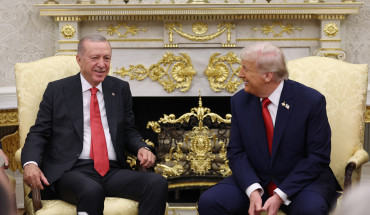"In some areas of the Gulf, you can’t tell whether you are in an Arab Muslim country or in an Asian district."
— Majeed al-Alawi, Bahrain Minister of Labor (October 2007)
In recent years, international labor migration has become a top socioeconomic and political issue worldwide. This increasing interest lies not only in the steady spread of the phenomenon and its pivotal role in the development of an increasing number of advanced industrialized countries, but mainly in the labor migrants “taking control” in the form of becoming a majority of the population in many residential areas in developed countries.
In the post-WW II era, there have been four main international labor migration patterns:
International Migration as a Basic Tool for Nation Building
In the English-speaking developed countries such as the United States, Canada, and Australia, the process of state building itself was based on large-scale migration. Hence, the labor immigration policy of these countries is a function of labor market needs, and in most cases, the migration process ends with the migrant laborers becoming citizens of the host country.
Temporary Labor Migration to the “Nation-State” Developed Countries
This pattern, which was and still is considered a “no choice option,” is the result of the labor shortage and population aging phenomena present primarily in the more developed European Union (EU) countries. These countries have tried to minimize the scale of labor immigration as much as possible in order to preserve their basic cultural-religious nature. Hence, their labor immigration policy is based on the Ricardian model of international trade. However, since these countries are democracies, in many cases the labor migrants have succeeded in becoming citizens of the host countries. The end result is that the percentage of migrants and their offspring is steadily increasing. This is the case, for example, in France, the United Kingdom, Belgium, Germany, the Netherlands, etc.
A Total Ban on Labor Migration
The leading country in this small group is Japan, which historically has treated labor immigration as a threat to its basic cultural-religious traditions and thus prevented it almost totally.
The Unique GCC Rentier Labor Migration Pattern
Although labor migration within the Arab region is not a new phenomenon — it already had started in the late 1930s, following the discovery of oil in the Gulf area — the scale of labor migration to the Gulf oil states was relatively small, estimated in the early 1970s to be between 800,000 and 1.25 million (including both workers and their accompanying family members).
The unprecedented scale of development projects of the GCC countries following the October 1973 “oil boom” led to an extremely rapid increase in the demand for foreign labor, as the GCC national workforces at that time were too small and without the required skills to execute these projects. Hence, while the short-term solution for the labor shortage was recruiting migrant labor, the longer term solution was the implementation of a pro-natalist policy (in order to maintain high fertility rates) along with a huge investment in education and vocational training in order to supply the necessary workforce from local sources.
It should be emphasized, however, that the Gulf royal families never considered addressing the labor shortage through mass naturalization of foreign labor due to the fear that mass naturalization would destroy the GCC states’ basic socio-political nature, which is based on a combined kinship and tribal system. An additional reason for this was the large resistance of the local populations, which perceived massive naturalization as a threat to their traditional cultural-religious values.
Hence, during the bonanza “oil decade” (1973-1982), the number of foreign laborers in the GCC countries rapidly increased, amounting to almost 4.4 million in 1985, a more than three-fold increase within a single decade. The total number of the foreign population was much higher, since many of the foreign workers, particularly the Arabs, were accompanied by their family members.
The surge in both oil prices and production scale on the one hand, and the small national populations on the other, transformed the GCC countries within a short period of time into pure “rentier states,”[1] with oil revenues amounting to 80% (and in some cases even higher) of the total governmental revenues. A major tool for distributing the oil income to the indigenous populations was through public sector employment with high salaries and luxury work conditions. Hence, the political implication of the rentier state was “no taxation and no representation.” The end result was the creation of a dual labor market with nationals employed almost exclusively in the public sector while the vast majority of the foreign workers were employed in the private sector.
In the mid-1980s, following the end of the “oil decade,” there was a widespread feeling that the process of rapid increase in the number of foreign laborers in the GCC countries had ended, and that from that point on, their numbers would steadily diminish. This feeling was based on the sharp decline of oil revenues and the completion of the major infrastructure projects. In addition, the indigenous workforces grew rapidly due to the accelerated population growth rates, along with a sharp improvement in its quality as a result of the huge investments in education and vocational training.
In retrospect, however, during the second half of the 1980s and throughout the 1990s, the number of foreign laborers in all of the GCC countries sharply increased, despite the implementation of labor nationalization policies to replace the foreign laborers with national workers in both the public and the private sector. By 1999, the number of foreign workers in the GCC countries totaled 7.1 million, representing almost 70% of the total GCC workforce and an increase of more than 60% compared to their number in 1985.
The steady increase in the number of foreign laborers is the result of a combination of liberal labor immigration policies and lax enforcement of labor regulations (e.g., the quota system, preference to nationals, etc.) which allows private employers much leeway in determining salaries and employment conditions. Thus, the vast majority of GCC foreign workers earn extremely low salaries of no more than a few hundred dollars monthly — much below the average salary of national employees. This leeway given to the private employers, it should be noted, was and still is a cornerstone of the rentier relationship between the GCC rulers and the merchant elite, who exchanged their political influence in the pre-oil era for economic benefits following the oil era.
Hence, although during the 1980s and 1990s, all of the GCC authorities repeatedly expressed their intention to implement labor force nationalization, in practice not much has been done. The former labor structure dichotomy of nationals employed by the public sector and foreign labor predominance in private sector employment remained in force. The only substantial change was the massive replacement of Arab foreign workers by nationals in the public sector. However, due to the rapid increase in the indigenous workforces on the one hand, and the diminishing oil revenues in per capita terms on the other, the number of available work opportunities for nationals in the public sector had become insufficient. The end result was a rapid increase of unemployment among nationals from barely 1% in the late 1980s to between 15% and 20% in the early 2000s — similar to the unemployment level in the non-oil Arab countries.
Moreover, the kafala (sponsorship) system[2] produced a unique situation in which nationals could earn money strictly by virtue of their nationality. An estimated 600,000 foreign workers in the United Arab Emirates (UAE) obtained work permits in this manner. A similar phenomenon prevailed in the other five GCC countries as well. Many of the GCC foreign workers are not crucial for running the economy. In the case of the UAE, for example, domestic servants represent as much as 5% of the total population! As the number of domestic servants one has is a status symbol, in many cases their number is higher than the number of the family members!
In recent years, the GCC authorities have realized that the large-scale replacement of foreigners by nationals in the private sector is not a viable option. The wage gaps, as well as the rentier socio-political formula, prevent it. In order to avoid “employment catastrophe,” they have shifted their labor force policy from decreasing dependence on foreign labor to creating job opportunities for nationals in the private sector by using massive amounts of cheap foreign labor, mainly from Southeast Asia. They thereby hope to achieve two major goals: decreasing unemployment among nationals and economic diversification away from oil production to the greatest extent possible.
Thus, in recent years, although the number of nationals employed by the private sector is steadily increasing, the number of foreign laborers is increasing much faster, amounting to 10.6 million in 2008. This represents an increase of almost 50% compared to their number in 1999.


[1]. The term “rent” refers to income driven not from work, but mainly from natural resources and foreign grants. The term “rentier state” refers to a situation in which the rental revenues predominate the governmental income, thus eliminating the need to tax the population.
[2]. According to the kafala system, a foreigner was not allowed to work in the GCC countries without local sponsorship (kafil). Once the employment relationship is broken, foreign workers become illegal residents, and must immediately leave the country.
The Middle East Institute (MEI) is an independent, non-partisan, non-for-profit, educational organization. It does not engage in advocacy and its scholars’ opinions are their own. MEI welcomes financial donations, but retains sole editorial control over its work and its publications reflect only the authors’ views. For a listing of MEI donors, please click here.












